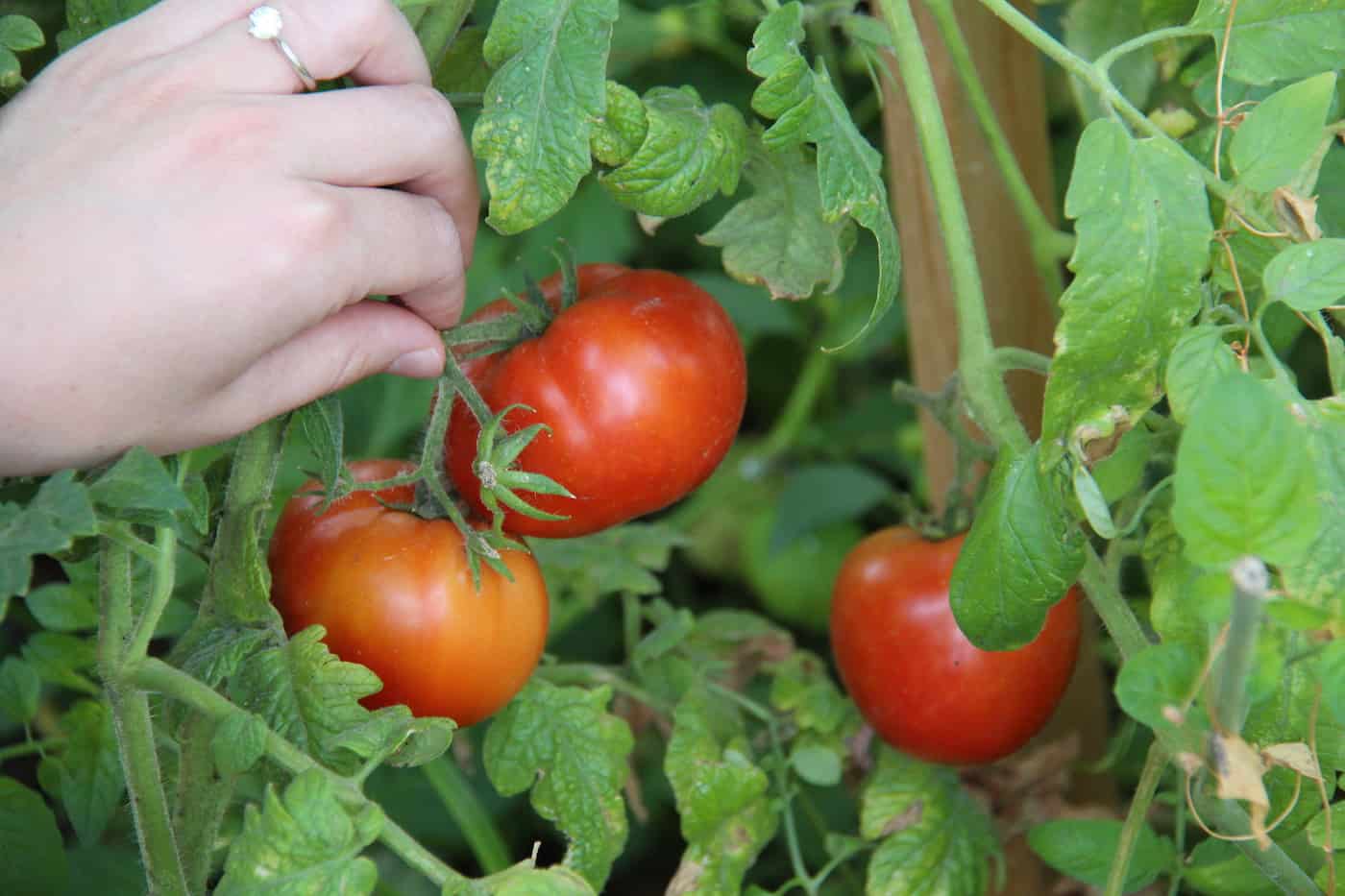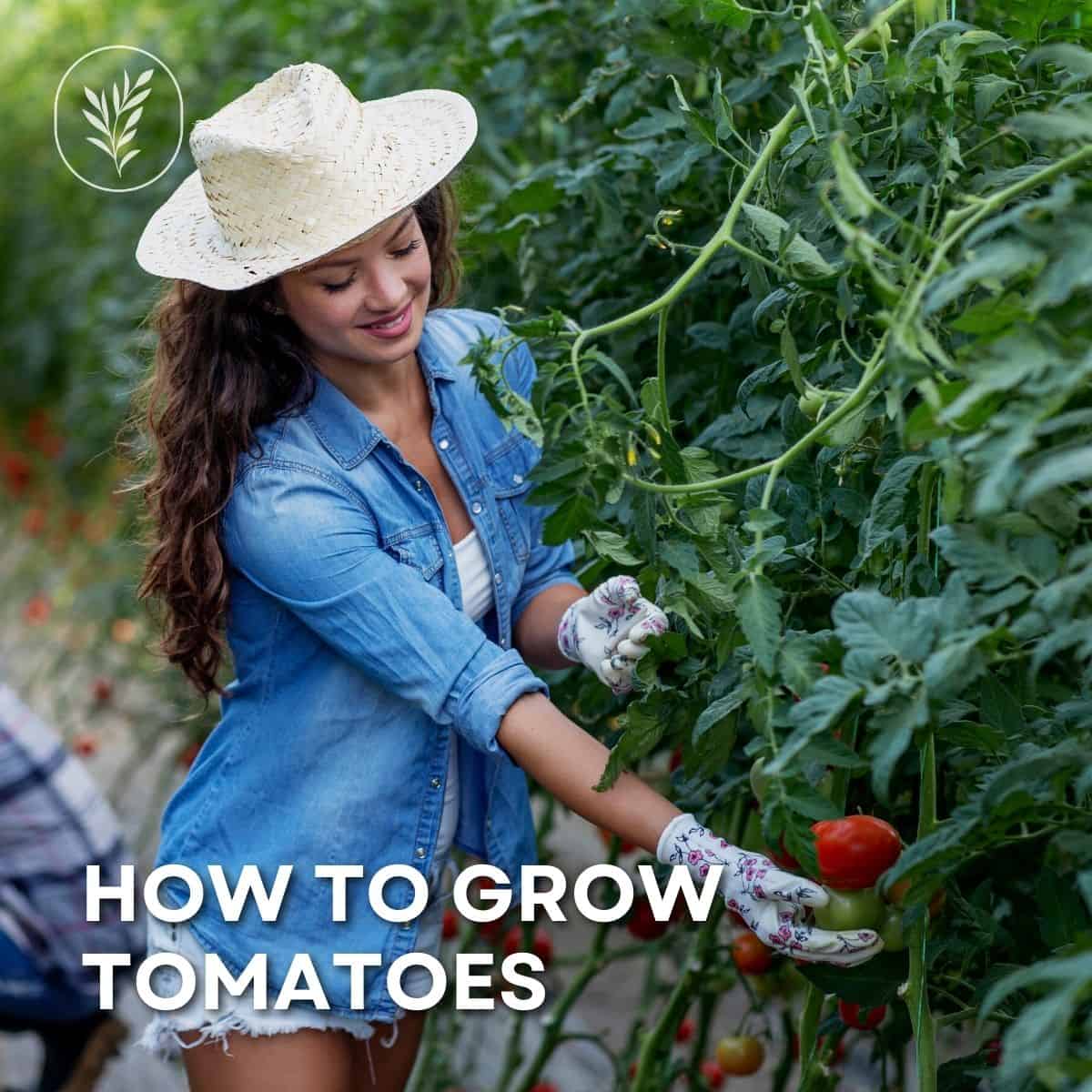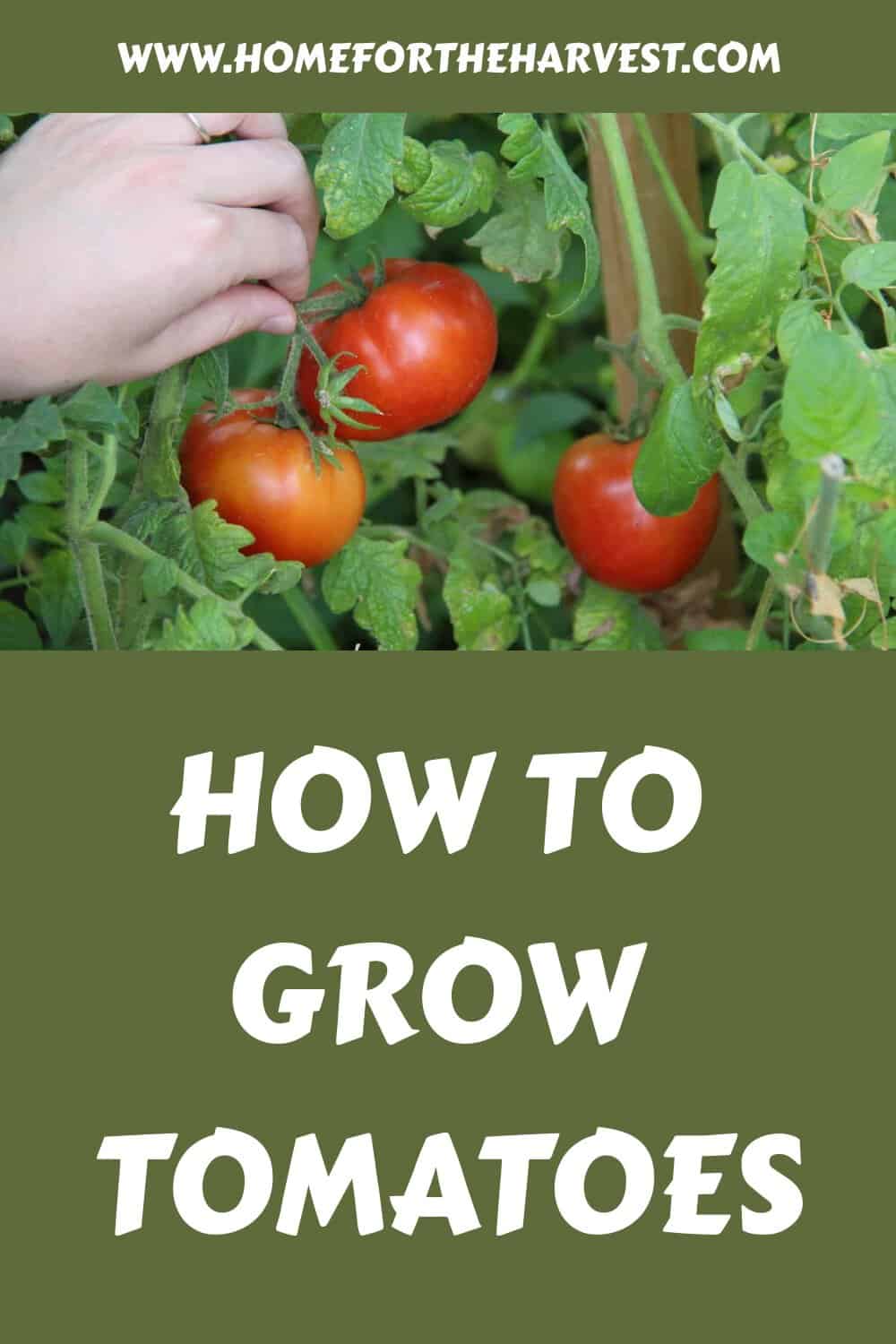Tomatoes are the highlight of the garden! Here’s everything you need to know about how to grow tomatoes, including which type to pick, how to plant them, and how to keep the plants healthy.
Here are the basics of growing tomatoes:
- Purchase locally-grown tomato seedlings from your local garden center, or grow your own from tomato seeds.
- Give the tomato plants the right amount of light, water, and heat – not too much and not too little (read on to learn how).
- Wait for yellow flowers to appear and bloom.
- Watch as tomatoes grow on the plant where the yellow flowers have faded. Yum!
Growing tomatoes is much easier than most gardeners think. Everyone can learn to plant tomatoes (even if your thumb isn’t green)! Read on to learn all about how to grow tomatoes in your garden.
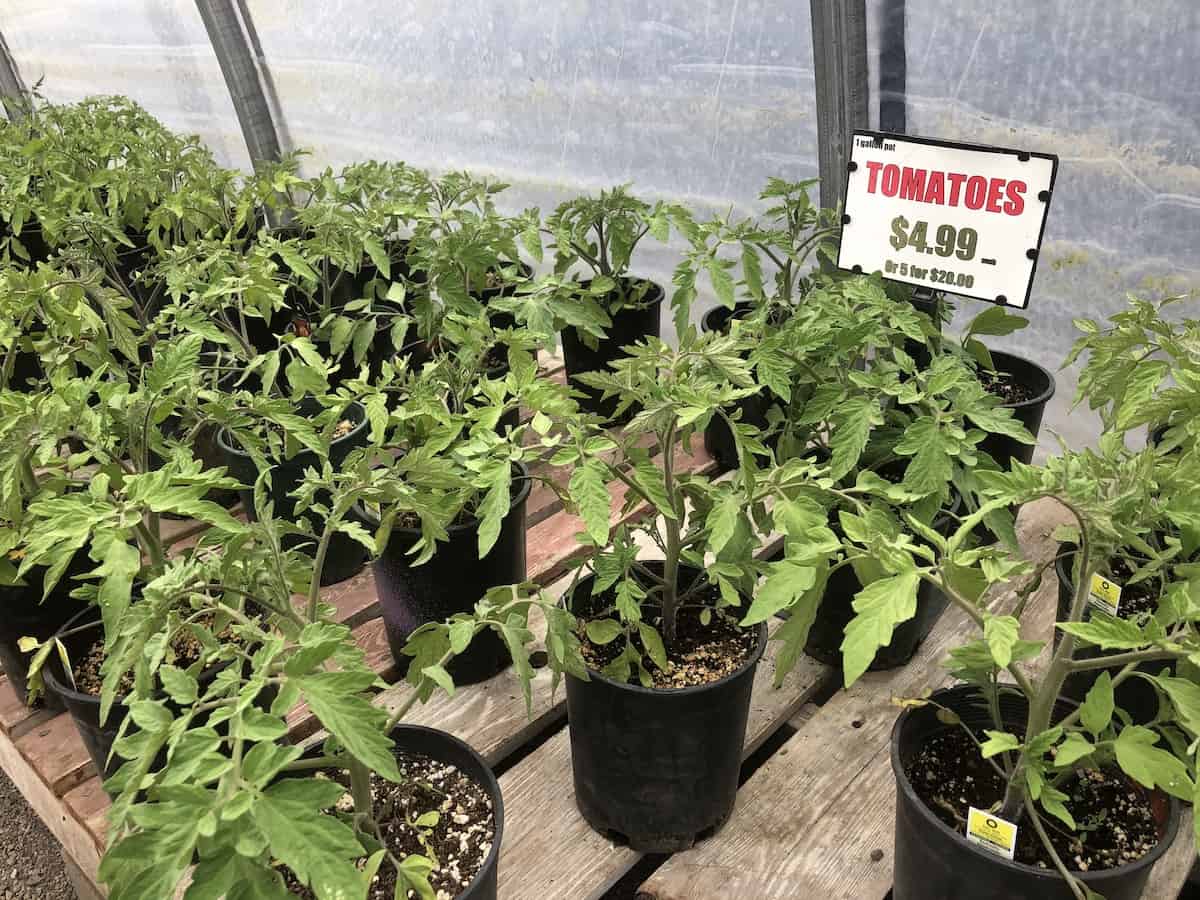
Supplies for growing tomatoes
Here are the supplies you’ll need for growing tomatoes in your garden:
- Tomato Seedlings
- Buy seedlings from the nursery (called “transplants”), or
- Grow your own tomatoes with seeds and potting mix
- Potting Mix
- Garden Soil
- Trowel
- Watering Can or Garden Hose with Nozzle
- Organic High Nitrogen Fertilizers (here is a detailed guide to organic plant food)
- Mulch (guide to mulch is located here – I use homemade compost!)
- Tomato Cage
- Area/Space for Growing Tomatoes
- Find a sunny patch of well-draining soil, or
- Grow your tomatoes in a large container
Planning your tomato garden
Time to plan your tomato garden! If you already have your garden planned out for the year, skip this step. If not, download a free copy of this garden planner I created to get your garden planned and scheduled out. Print it out and you’ll have your garden planned in about an hour.
Choose varieties of tomatoes to grow
The first step to growing tomatoes is to decide which variety (cultivar) to grow and figure out how many plants you’ll need. You’ll also need to decide when to start your tomato seeds or when to purchase seedling plants from the nursery. This is all part of garden planning.
I generally pick which tomatoes to grow based on taste. Here are some of the best-tasting types of tomatoes to grow and eat fresh from the garden. While most prefer sweet tomatoes, tart and sour tomatoes are also popular! Try growing a Black Krim Tomato or the Black Cherry tomato.
Want to grow tomatoes for specific recipes? Here are the best tomatoes for sandwiches, sauce or toast.
I grow Sun Gold Tomatoes for a hybrid cherry tomato and Brandywine Tomatoes for a giant heirloom type. Gardeners in cooler climates with a short growing season do well with Early Girl Tomatoes.
Consider a “canning-type” variety if you’ll be canning the tomatoes at the end of the season. It’s nice to plant a diverse group of varieties, but if you can only grow one, that is fine too.
Dwarf or determinate tomatoes are nice if you’re going to be growing tomatoes in a container garden. Hybrid cherry tomatoes are nice because they don’t take as long to grow fruit as the big heirloom types. Here is an article describing the difference between “heirloom, hybrid, and organic” seed varieties.
Tomatoes aren’t just red either! You can grow purple or yellow tomatoes to brighten up your vegetable garden.
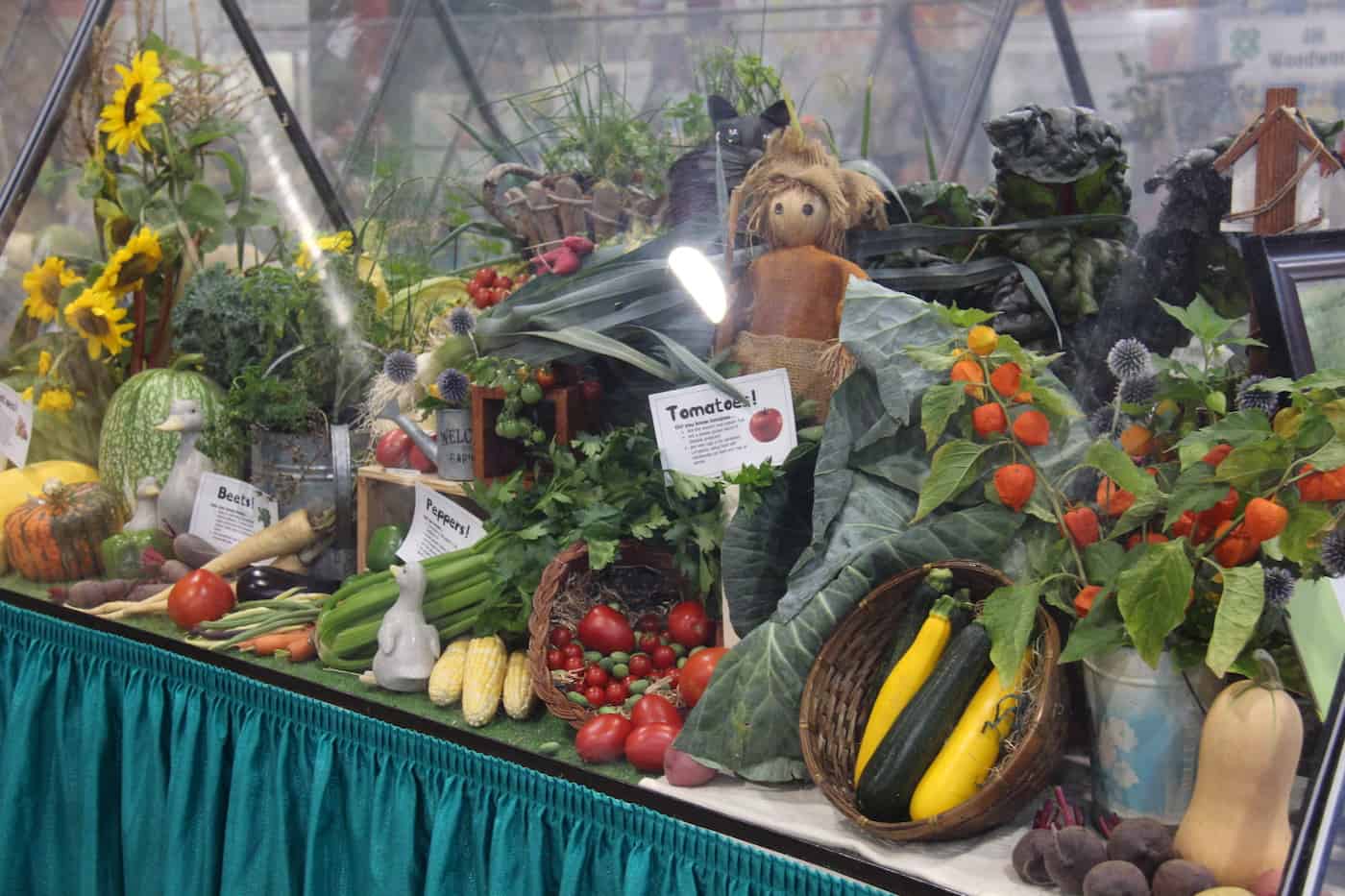
Planning where to grow your tomato plant
If you haven’t already planned where to situate your tomatoes, now is the time (here’s your free garden planner). Tomatoes grow best outdoors in sunny areas that have well-drained soil. The two most important site characteristics are:
- A sunny area that receives at least 6 hours of sunlight each day, and
- An area with well-drained soil (think sandy loam, not heavy clay).
This could be a sunny patch of in-ground soil, a nice raised bed, or a plant pot placed in the sun. It’s completely possible to grow tomatoes on a balcony as long as it gets enough sun.
Plan on each plant taking up a surface area of 2 feet by 2 feet in a garden or raised bed. Also, look for an area with good air circulation all around the planting area. Lastly, plan to plant good tomato companion plants nearby.
In pots, large, indeterminate heirloom tomatoes like Brandywine will need 10 or 15-gallon containers (generally 18 to 24 inches wide). Dwarf and determinate tomatoes can be grown in a 5-gallon pot or bucket with drilled drainage holes.
“Using creative staking and container gardening allows anyone with good sun exposure to have a productive garden. Every year my driveway becomes my main area for growing tomatoes, along with peppers and eggplant.”
Epic Tomatoes: How to Select and Grow the Best Varieties of All Time, by Craig LeHoullier
Growing a tomato plant from a seed
Tomato seedling transplants are grown from tomato seeds. This is done indoors, generally with the help of a dedicated plant light and seedling fan for air movement. Most gardeners start their tomato seeds about six weeks before the average last frost date in their area.
Soak tomato seeds for 6 hours before planting. Use a quality organic seed-starting potting mix. Plant two seeds per pot, thinning to one seedling if both grow. Give each seedling plant room (don’t crowd them).
“You put two seeds into each cell because there’s always the occasional bad seed that doesn’t want to sprout. But you don’t want to keep both of the plants you’ll now have in most of those little cells. Nope.”
The “You Bet Your Garden” Guide to Growing Great Tomatoes, by Mike McGrath.
Tomato seedlings need direct light. A sunny window will generally not be enough light for them and can lead to leggy tomato transplants. Here is an article all about how to grow healthy seedlings from seeds.
How to plant a tomato seedling plant
Here’s how to plant a seedling. Young tomato plants are often called “transplants” as they will be “transplanted” out into the garden.
How to prepare the soil for tomato plants
So, how do you prepare the soil for tomato plants? Many gardeners like to prepare the soil by placing a 1-2 inch thick layer of compost over the soil surface.
This soil preparation can be done in the fall or early spring. Some garden soil will need little preparation prior to planting tomatoes (get a proper soil test done at a local extension office or agricultural school).
“All soil can be improved by adding compost. In fact, any kind of organic matter that absorbs and holds water, or provides air spaces, will change things for the better.”
Epic Tomatoes: How to Select and Grow the Best Varieties of All Time, by Craig LeHoullier
A nice layer of homemade compost will add organic matter and nutrients to the soil. You’ll also want to start saving up your eggshells (more on that below).
When to plant a tomato plant outdoors
Tomato plants grow best outdoors, but they don’t like the cold. It’s best to wait not only until the last spring frost has passed but also until the soil has warmed up a bit.
“Everyone grows their tomatoes in the summer – unless they live in Arizona, southern Texas, or some other place so hot they have to grow their tomatoes over the winter and live in deep holes in the sand all summer to escape the heat.”
The “You Bet Your Garden” Guide to Growing Great Tomatoes, by Mike McGrath.
Your transplants won’t quite be ready for the outdoors after a lifetime inside. “Harden them off” a little bit each day by putting young plants outdoors in the shade for a couple of hours the first day.
Gradually increase the amount of time the plants are outside each day, and start exposing them to some direct sunlight. This process will ease the transition.
“I harden off seedlings at two different points: before transplanting, when they are still in their small growing cells, and following transplanting into their individual containers.”
Epic Tomatoes: How to Select and Grow the Best Varieties of All Time, by Craig LeHoullier
If you remember one thing from this, remember not to rush the season! Tomatoes DO NOT LIKE cold weather. We’re talking about any outdoor air temperature below 50 degrees Fahrenheit (10 degrees Celsius). Tomato growth is severely inhibited below 50 degrees and the plants are significantly injured below about 43 degrees.
Here are a few quotes about the negative effects of cold temperatures on tomatoes that I like to remember when I reeeeeeallly just want to put the tomatoes out in the garden:
- “The cultivated tomato, Lycopersicon esculentum, is a classic example of a chilling-sensitive plant. Temperature below 10 degrees Celsius severely inhibit tomato growth and development at all life stages, and those below 6 degrees Celsius inflict significant injury (Geisenberg and Stewart 1986).”
- “Chilling impedes root growth of chilling-sensitive species. The roots of cultivated tomato cease to grow at 10 degrees Celsius, and growth is slow to recover after rewarming (Scott and Jones 1986).”
- “Chilling the roots of the cultivated tomato damages ammonium influx, but not nitrate uptake or ammonium efflux (Bloom et al. 1998). Less than two hours of exposure are sufficient to cause damage, but more than eight hours at moderate temperatures are required for recovery.”
The quotes above about the effects of chilling on cultivated tomato plants are from the text Mineral Nutrition of Plants: Principles and Perspectives, by Emanuel Epstein and Arnold J. Bloom.
Still have questions? No worries! I’ve made a guide on the best time to transplant tomato seedlings to the outdoor garden.
How to plant a tomato in the garden
At this point, you’ve got your healthy tomato seedling plant which has been “hardened off” to life outdoors. You’ve also got your nice garden soil which has been prepared with an inch or two of homemade compost. And you’ve been saving up your eggshells. Now is the time to start planting!
Dig a wide, deep hole for each tomato plant. Use the layout map in your garden planner and make sure you’re leaving enough space to walk between rows to tend and harvest. Water each planting hole if the soil is dry.
Then add crushed-up eggshells to each planting hole. Save or find enough cleaned eggshells so you can add the crushed shells from a dozen eggs into each hole. This will add calcium to the soil and prevent blossom end-rot. DO NOT try to substitute in Epsom salts for eggshells.
If the seedling is at all “leggy” – meaning that it is tall and skinny rather than leafy and bushy – it should be buried deeper than the soil line in the pot. Tomatoes are unique in that roots form along any part of the tomato stem that’s planted below the soil. The buried stem becomes an extension of the tomato’s tap root, helping it absorb more moisture and nutrients. Pinch off the bottom leaves and bury about half of the stem below the ground.
Water the tomato transplant well after planting. Some gardeners like to build a little “well” or “moat” out of the soil around the stem to keep water in the vicinity of the tomato’s tap root. Avoid overwatering, as that will cause your tomato plant’s leaves to yellow.
Not overwatering but leaves still yellowing? Here are some reasons why.
Mulching tomato plants in the garden
The soil around your tomatoes should be mulched once the soil has had a chance to fully warm up. I like to mulch my tomatoes about a month after planting them outside. I mulch mine with more homemade compost, which helps keep moisture in the soil and discourage weeds from growing. The compost is also less likely to splash up onto the foliage during a rainstorm.
“Compost used as a mulch prevents weeds just as well as shredded bark or wood chips (both of which breed disease and are bad for plants), provides all the foods our growing plants need, and prevents disease spores from breeding on the surface of the soil (wood and bark mulches encourage such sinister spores – did I mention that wood mulches are bad?).”
The “You Bet Your Garden” Guide to Growing Great Tomatoes, by Mike McGrath.
How to plant a tomato in a container
Plant tomatoes in containers as long as the container is large enough has drainage holes, and is watered frequently.
Plant one seedling in each container. Use a quality potting mix made of peat moss/coconut coir and perlite. Add some nutrients to the potting soil by adding compost. Avoid using plain garden soil in a container garden if possible. Place the pot in a sunny area that’s getting at least 6 hours of full sun daily. Plants in super-sunny southern areas may benefit from a bit of afternoon shade in the hottest months. Sunny spot tomato plants grow much better than ones that grow in dark or shady environments.
Container tomatoes dry out much more quickly than plants in the ground. Use a drip irrigation system to water them and be sure to check them every day.
How to use tomato cages
Most tomatoes will benefit from some sort of support system. Small hybrid tomatoes can get away with a small tomato cage, while larger indeterminate tomatoes are best off with a custom-built support system. The supports will keep the fruits off the ground and prevent rotting. Place the tomato cage soon after planting (before the tomato has the chance to get bigger!).
Many serious tomato gardeners use animal fencing from the hardware store to make rigid wire cylinders. One fifty-foot roll of metal wire fencing will make up to 10 tomato cages. If you’re wanting to get really fancy, try either concrete reinforcing wire (that looks like animal fencing with a wider grid), or find a specialized “Gard’n Fence (which is coated in dark green covering – nice to look at).
If making your own tomato cages, which is recommended, consider making them in a few sizes. That way they can nest inside the largest cage(s) for winter storage. This is nice if you have lots of tomato cages….which you will.
If you don’t want to construct a tomato cage, an easier-to-use alternative are tomato stakes. Similar to tomato cages, they provide vertical support and are cheaper and quicker to assemble.

How to care for a tomato plant
Caring for a tomato plant is easy if the seedling is healthy and planted with care. Even in less-than-ideal circumstances, tomatoes are easy to grow.
“Seriously, if you got your plants off to a good start, buried ’em deep, fed ’em eggshells, mixed some compost into their loosened-up soil and/or spread some on top of their already good soil, gave ’em plenty of air space, mulched ’em well, and all the other stuff you didn’t do, you can use kick back for the next couple of months. Unless drought strikes. They you have to wake up and water.”
The “You Bet Your Garden” Guide to Growing Great Tomatoes, by Mike McGrath.
Watch your tomato plants carefully to catch disease or pests early on. Visit them every day to make sure they are getting adequate sunlight and moisture. The plants may also need to be protected from local wildlife with fencing or some other deterrent.
How to water a tomato plant
Tomato plants should be watered deeply, infrequently, and not allowed to sit wet overnight. Water the seedling deeply when it is first planted out in the garden. Keep the fresh potting soil moist (but not sopping wet) for a couple of days.
Keep watering regularly, but allow the soil to dry out a bit between waterings. Tomato plant roots need access to both air and water.
“Yes, plants really do want to have their tootsies dry out completely between waterings. Don’t you?”
The “You Bet Your Garden” Guide to Growing Great Tomatoes, by Mike McGrath.
About a month after planting, you’ll mulch the soil (as described above). This will help the soil retain moisture as temperatures heat up. Keep checking the plants often. Give them enough sun and water to grow, but don’t overload them with water. Encourage the roots of the tomato to grow deep and therefore have access to greater reserves of water (and less at the mercy of the sun).
“The root of the tomato plant is typically of the “taproot” variety. The taproot is a primary larger root that is parallel to the main stem and runs fairly deep. Lateral roots will branch off the taproot and sublateral roots will also branch off the lateral roots.”
The Complete Guide to Growing Tomatoes: Everything You Need to Know Explained Simply – Including Heirloom Tomatoes, by Cherie H. Everhart.
Soil moisture becomes even more important as the fruit ripens. Avoid overwatering the plant at this point. A spike in moisture can cause rapid swelling of the fruits, leading to the cracking of the tomatoes. Use drip irrigation, mulch, and careful observation to keep soil moisture levels consistent as the fruit ripens.
“With very little watering you get a much better flavored tomato”
Tom Wagner – Breeder of the popular Green Zebra tomato
It’s best to water tomato plants in the early morning. Keep the water off the foliage – only the soil needs to be watered. Avoid watering at the end of the day and avoid watering the leaves.
“When the transplants are well established, you can cut back on watering. Once plants set fruit, they should be able to survive without additional watering beyond rainfall. While the plants may wilt somewhat in the afternoon sun, if the root systems are strong, they can survive dry periods better than you might expect.”
The Complete Guide to Growing Tomatoes: Everything You Need to Know Explained Simply – Including Heirloom Tomatoes, by Cherie H. Everhart.

How to fertilize a tomato plant
A nice layer of compost is all most tomato plants need to produce lovely, delicious fruits. Composts are the best high-nitrogen fertilizers to use on tomatoes. Nothing is better than homemade compost for tomato food!
“Compost is unbeatable; we’re talking the King and Queen of garden nutrients!”
The “You Bet Your Garden” Guide to Growing Great Tomatoes, by Mike McGrath.
Avoid using synthetic chemical fertilizers on your tomatoes. They simply don’t need it. Every serious tomato grower I know has eventually moved to 100% organic growing methods (even those who once loved their 10-10-10).
“After working with chemicals for many years, he realized that there were too many problems. “If you can’t trust yourself using chemicals,” he said, “how do you trust the other guy using chemicals?” He now supplements with alfalfa meal, kelp, dolomite, worm castings, compost and other natural soil additives, while breeding plants that are naturally healthier and more disease resistant.”
Something of a legend: An interview with Tom Wagner, by Jessamyn Tuttle, Grow Northwest.
“I know you don’t believe me when I say you shouldn’t feed your plants, so feel free to ignore my sage advice (go ahead and side with my family! I knew you were against me!). But if you do feed your plants every two weeks like a certain actor-turned-chemical-salesman tells you to on TV, they’ll look like you would if you at a triple-size burger and fries three times a day.”
The “You Bet Your Garden” Guide to Growing Great Tomatoes, by Mike McGrath.
If you really feel the need to give your tomato plants a “boost”, choose a naturally-sourced soil amendment that is safe for organic gardening. Here is a detailed guide to organic fertilizers, which are a much safer and more effective option. Avoid using Epsom salt on your tomato plants. Despite what you read on Pinterest, Epsom salts are not good for tomato plants.
“Liquid mixtures of fish and seaweed are my favourite mid-season boost fertilizers.”
The “You Bet Your Garden” Guide to Growing Great Tomatoes, by Mike McGrath.
Tomato plant pollination
Most tomato plants are self-pollinating, meaning that one flower can pollinate itself or other flowers on the same plant. While they don’t rely on insect pollination, it will take a bit of movement to move the pollen (even the wind).
Heirloom tomatoes pollinate themselves and breed true to parent plants from generation to generation. They’re the perfect varieties for saving tomato seeds to plant next year.
Modern hybrids are also self-pollinating, but the seeds in the resulting tomatoes won’t grow plants that are the same as the parent plant. You’ll have to buy new hybrid seeds next year (so get in line to buy those Sun Gold seeds!).
How to prune a tomato plant
Tomato plants require minimal pruning. While some gardeners “prune the suckers off” because they “sap energy from the plant”, there is little evidence to support this. In fact, the suckers are actually fruiting side shoots that develop at nodes. Removing suckers by pruning them off will reduce the yield of the plant, NOT increase it.
So why would you prune a tomato plant? Perhaps the most entertaining source on this subject is Mike McGrath, the former longtime editor of Organic Gardening magazine:
“You’ll have a handy excuse for avoiding those treacherous family reunion picnics, mosquito- and blackly-infested hikes, frolics in freezing cold ocean waves, and other festive seasonal outings you’d be dragged to if you couldn’t say, “Gee, I’d love to go, but I performed a biodynamic copper flange pruning on my tomato plants last night, and I have to stay here and spray them with compost tea that was fermented in a ram’s horn under a full moon, or the pistils won’t be firm.””
The “You Bet Your Garden” Guide to Growing Great Tomatoes, by Mike McGrath.
Some gardeners do like to “top” tomato plants – trimming the main stem to encourage the lateral branches to grow. This isn’t necessary; however, it’s more of a personal preference. Gardeners who prune their tomato plants often also trim all the lower leaves off the bottom foot of the stem once the plant is a few feet tall as they can get a little scraggly with splashing.
Even gardeners who don’t prune their tomatoes may have to pinch some suckers off a large and unruly indeterminate tomato. This can help with air circulation and make the supporting trellis more reasonable.
“Unpruned tomato plants tend to have a main stem that dominates growth and inhibits the growth of lateral branches. Hower, once the primary stem flowers, growth in this main stem terminates and lateral branches begin to grow more aggressively.”
The Complete Guide to Growing Tomatoes: Everything You Need to Know Explained Simply – Including Heirloom Tomatoes, by Cherie H. Everhart.
Do go easy on pruning though. Remember that the leaves are the equipment that the plant uses to create sugar to give flavor to your delicious homegrown tomatoes. Don’t deprive the plant of its essential equipment! Exercise caution whenever pruning any plant.
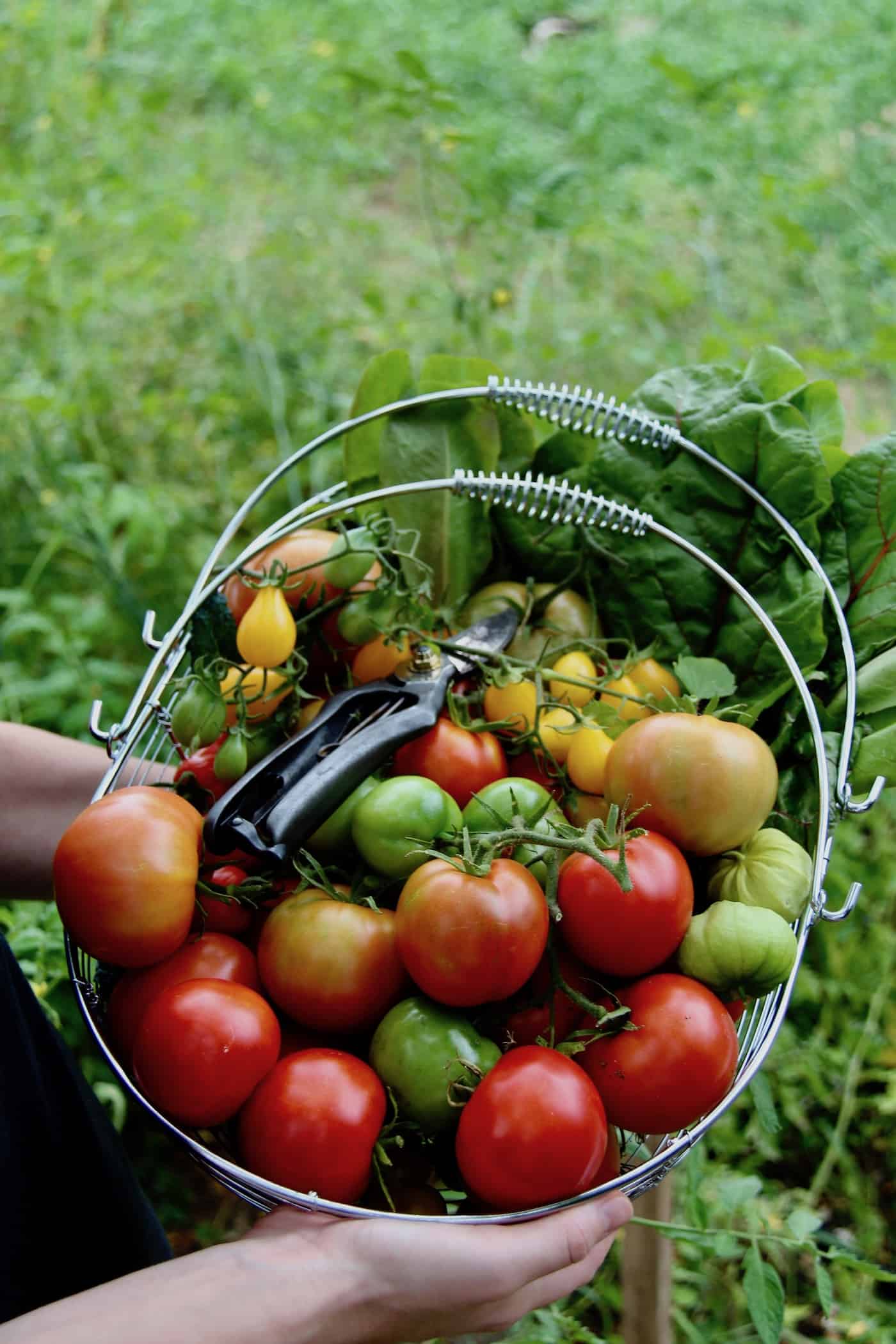
Harvesting tomatoes from the garden
Tomatoes ripen best on the vine. Leave the fruit on the plant as long as possible. That being said, pick up any tomatoes that fall off before they ripen and bring them indoors to let them ripen up.
“Don’t worry – growing tomatoes is like raising children: Perfection on your part is simply not possible. You’re going to screw up, but they’ll probably be just fine anyway as long as you tried your best.”
The “You Bet Your Garden” Guide to Growing Great Tomatoes, by Mike McGrath.
When to harvest tomatoes
Tomatoes are ripe and ready to be harvested when they are still quite firm but are just starting to get a little plumpness to them when squeezed lightly. They should also be their final ripened color (which varies dramatically based on the variety).
If there are still tomatoes on the vine when a hard frost is forecast, it’s time to pick them all (regardless of ripeness). Take the tomatoes inside and let them ripen indoors. Some gardeners even hang their whole plants upside down on a covered porch or other protected area until the tomatoes ripen! Just don’t put the tomatoes in the fridge or leave them out in the cold.
“What could be more Italian than sun-ripened tomatoes, sweet and still warm from their ripening in the garden. A drizzle of the best olive oil and a bit of ripped basil… heaven.”
Italian Kitchen Garden, by Sarah Fraser
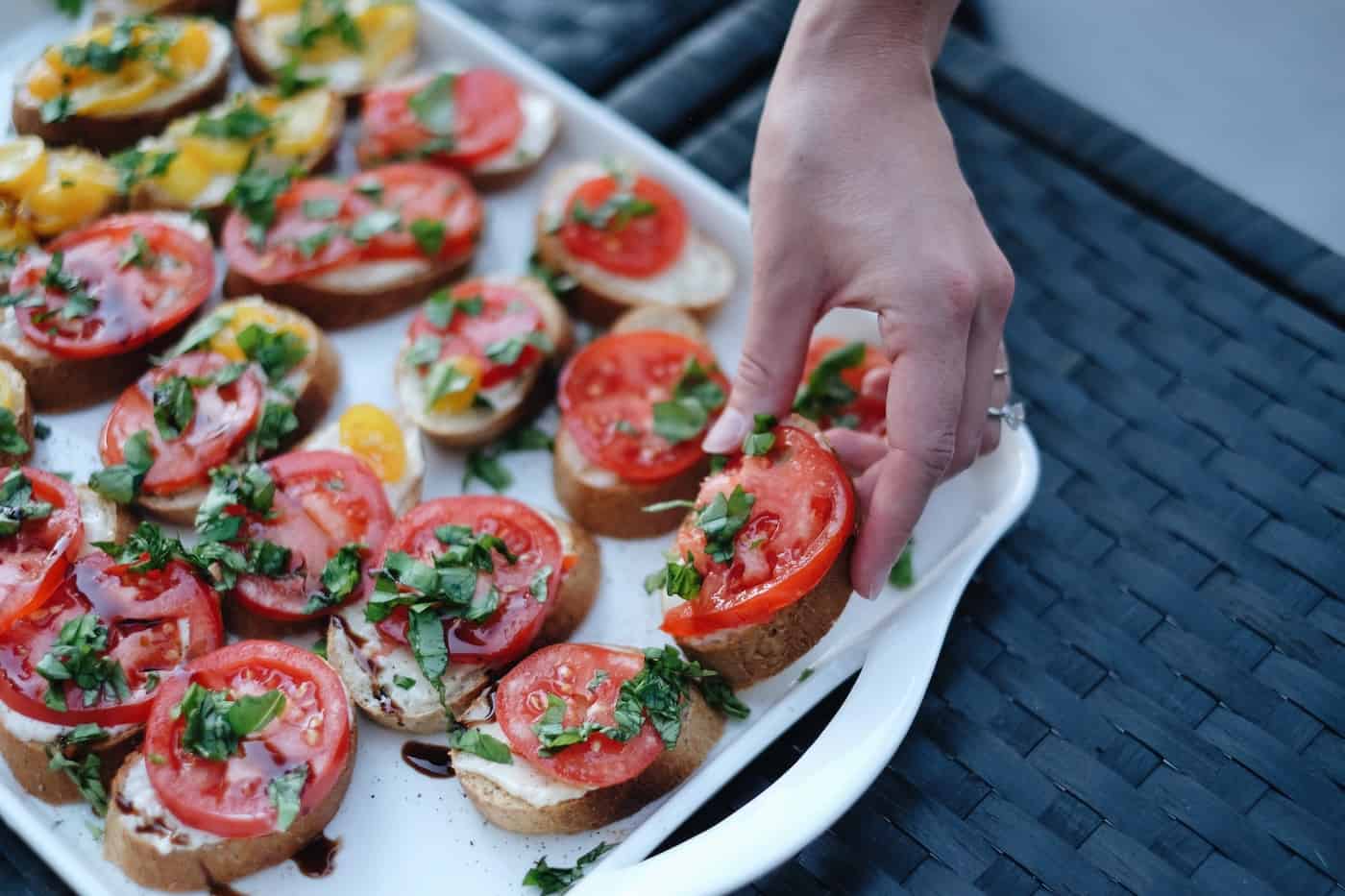
How to store ripe tomatoes
Store near-ripe tomatoes in a warm spot, and after they ripen, switch to a cool spot. Don’t refrigerate fresh tomatoes. Doing so spoils the flavor and texture (think of that awful mealy texture that refrigerated store-bought tomatoes get).
Store ripe tomatoes at room temperature in a brown paper bag. To make them last longer, consider freezing them. Blemish-free tomatoes can be frozen whole. Tomatoes can also be halved or quartered prior to freezing. If freezer space is at a premium, consider removing the seeds and pulp from the tomatoes so you can really pack in the pulp.


